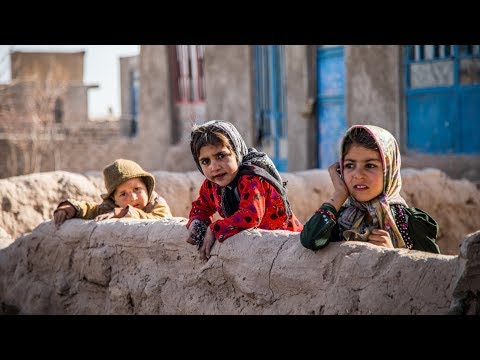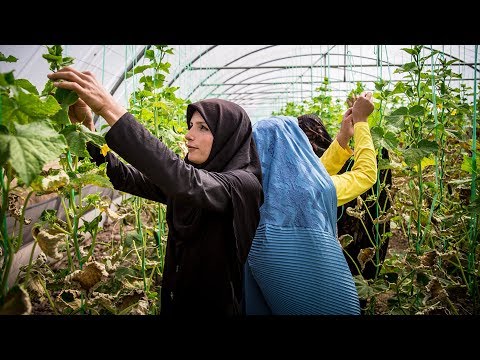
The UNDP-supported and GEF-LDCF funded project, Strengthening Livelihood Resilience & Managing Disaster Risks for Afghan communities, focuses on delivering tangible socio-economic benefits by investing in and restoring ecological infrastructure such as rangelands. Rangelands are vital to the Afghan economy since they support livestock production and related industries and provide natural products such as fruits and nuts. With the enhanced resilience of ecosystems, climate change induced changes and extreme events are likely to be more gradual and less severe than under a ‘business as usual’ scenario. This will help reduce livelihood losses from severe climate events. Finally, investments in small-scale rural infrastructure such as water management and irrigation will contribute to higher food security and poverty reduction for those currently operating on rain fed land.
In the long-term, strengthening the resilience of Afghan communities to climate change will require a step change in current practices. To begin with, a greater level of awareness and a more robust knowledge base of climate change impacts are required. Policy and planning must fully incorporate climate risks, particularly in the District Development Plans and Community Development Plans. Restoring the depleted natural resource base and managing it in a more sustainable manner is a fundamental component of building resilience. Moving beyond subsistence agriculture to food and income security, along with a shift toward more diverse and less vulnerable livelihoods, is also essential. Finally, large-scale investments in climate-resilient infrastructure such as storage reservoirs and more efficient irrigation systems are another important pre-condition.
- Community
- Country Office
Rural communities in Panjshir, Balkh, Uruzgan and Herat Provinces
- Ministry of Agriculture, Irrigation and Livestock (MAIL)
- ICIMOD
- United Nations Development Programme (UNDP)
- Global Environment Facility (GEF)
While Afghanistan has made measurable progress in human development over the past six years, it remains one of the poorest and most vulnerable countries in the world. It ranked 172 in UNDP’s Human Development Report 2011. The Global Adaptation Index ranks it as the most vulnerable country in the world, taking into account the country’s exposure, sensitivity and ability to cope with climate related hazards. Climate change scenarios for Afghanistan suggest temperature increases of up to 4°C by the 2060s (from 1970-1999 averages), and a corresponding decrease in rainfall. The biophysical effects of climate change are expected to be significant; droughts are likely to be the norm by 2030 leading to associated dynamics of desertification and land degradation. Coping with the impacts of climate change is a major challenge for development in Afghanistan given that its negative effects are likely to be most severely felt by the poor and marginalized due to their high dependence on natural resources and limited capacity to cope with the impacts of climate variability and extremes.
Afghanistan has a predominately dry continental climate with wide extremes of temperature. High mountain ranges characterize much of the topography; a quarter of the country’s land sits at more than 2,500m above sea level. While annual precipitation exceeds 1,000mm in the upper mountains of the northwest, it is less than 400 mm over 75 percent of the country and virtually all of the cultivable land. The cultivable area of Afghanistan is estimated to be 7.7 million ha, representing about 12 percent of the country’s area. Approximately 42 percent is intensively or intermittently irrigated. The importance of irrigated agriculture cannot be overstated, since it is the mainstay of food security and income for the majority of the rural population, accounting for more than 70 percent of total crop production. The 2008 State of the Environment report makes it clear that water is the country’s most critical natural resource and key to the health and well-being of the Afghan people.
The main climatic hazards identified in the NAPA are periodic droughts, floods due to untimely and heavy rainfall, flooding due to the thawing of snow and ice, and increasing temperatures (see Table 1). There is a discernible trend that these events are occurring more regularly and are more intense in nature. There have been severe flood or drought events in 8 out of the past 11 years. In fact, the period 1998-2006 marked the longest and most severe drought in Afghanistan’s known climatic history. At the same time, flood risk is also increasing as rainfall patterns have become more erratic. Areas that traditionally receive 250 mm of rain over a period of six months are now receiving that amount of rainfall during the course of only one or two months, with a devastating effect on agriculture and livelihoods. Unless action is taken to strengthen the resilience of Afghan communities and reduce disaster risk, climate change impacts will jeopardize development gains and could push an even greater number of Afghans into poverty.
'Reasons to Bee Cheerful: Raising Incomes, and Letting Bees Do the Work', UNDP Aghanistan, October 17, 2018. Under its livelihoods component, the Climate Change Adaptation Project provided beehives, beekeeping tools and jars for honey, and, crucially, a 12-day training that gave beneficiaries the necessary skills to maintain a beekeeping business.
'High Water Everywhere', UNDP Afghanistan, May 28, 2018. Flood waters are among the most destructive of natural hazards; they can rise with incredible rapidity, and be a serious risk to life, as well as causing immense damage to property, crops, and livelihoods. Shade Bara’s situation makes it prone to flooding. To address the problem, the project constructed an 1120-meter protection wall to protect 40 hectares of land and property from heavy flooding.
'Windows of Happiness', UNDP Aghanistan, October 15, 2017. Under its livelihoods component, the project provided beneficiaries with a greenhouse, seeds for vegetables, as well as the necessary training to become a successful small-scale farmer.
Water, the gift of life, returns to Safar Khan by Climate Adaptation UNDP on Exposure
When the levee breaks by Climate Adaptation UNDP on Exposure
Afghanistan LDCF-funded climate adaptation project
- 1.1 Mainstreamed adaptation in broader development frameworks at country level and in targeted vulnerable areas
- 1.2 Reduced vulnerability to climate change in development sectors
- 1.3 Diversified and strengthened livelihoods and sources of income for vulnerable people in targeted areas
- 2.3 Strengthened awareness and ownership of adaptation and climate risk reduction processes at local level
Expected Outcomes | Expected Outputs |
Climate change risk and variability integrated into local planning and budgeting processes
| Climate change scenarios developed for the agriculture sector in selected provinces
Trained at least 250 provincial MAIL officials, farmers and pastoralists on climate risk information and appropriate response measures
10 climate sensitive Community Development Plans formulated
|
Rural income and livelihood opportunities for vulnerable communities enhanced and diversified
| At least 100 women trained on alternative livelihoods to farming (e.g. embroidery and carpet weaving)
Business development training in handicrafts and small-scale manufacturing provided to 20 rural entrepreneurs and 10 SMEs
2,000 hectares of degraded rangelands planted with stress resistant seedling varieties
|
| Productive infrastructure improvements | Small-scale storage reservoirs (less than 20m high) built in selected river sub-basins in 10 communities
Micro-water harvesting techniques introduced in 10 communities
20 karezes[1] and canals improved and rehabilitated to reduce water losses
At least 20 check dams, contour bunds and other facilities built to conserve water and enhance groundwater recharge
|
[1] A kareze is an underground canal system that taps aquifers by gravity through a series of subsurface tunnels. It often extends for many kilometers before surfacing to provide water for drinking and irrigation.
More information to come...
More information to come...



